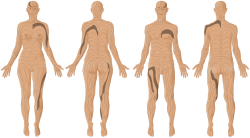Blaschko's lines

Editor-In-Chief: Prab R Tumpati, MD
Obesity, Sleep & Internal medicine
Founder, WikiMD Wellnesspedia &
W8MD's medical weight loss NYC, sleep center NYC
Philadelphia medical weight loss and Philadelphia sleep clinics
| Blaschko's lines | |
|---|---|

| |
| Synonyms | Lines of Blaschko |
| Pronounce | N/A |
| Specialty | Dermatology |
| Symptoms | Skin patterns following specific lines |
| Complications | N/A |
| Onset | Congenital |
| Duration | Lifelong |
| Types | N/A |
| Causes | Genetic mosaicism |
| Risks | None |
| Diagnosis | Clinical observation |
| Differential diagnosis | Langer's lines, Köbner phenomenon |
| Prevention | N/A |
| Treatment | None required |
| Medication | N/A |
| Prognosis | Benign |
| Frequency | Common |
| Deaths | N/A |
Blaschko's Lines, named after the German dermatologist Alfred Blaschko, represent pathways of embryonic cell migration during the development of the skin. Under normal circumstances, these lines are invisible and only become visible when certain skin disorders, typically those of a genetic or mosaic nature, manifest along these patterns.
Discovery[edit]
Alfred Blaschko first demonstrated these lines in 1901, not based on dissection or inspection of skin tissues, but by meticulously noting and sketching patterns of skin rashes and moles on his patients.
Characteristics[edit]
Blaschko's lines do not correspond to nervous, muscular, or lymphatic systems, but rather seem to follow the pattern of cell migration during embryonic development. They form a 'V' shape on the back, 'S' shaped spirals on the chest and sides, and wavy shapes on the head.
Clinical Significance[edit]
Blaschko's lines are significant in the field of dermatology and genetic medicine as they can provide clues to the nature of skin diseases and conditions. Mosaic Disorders: Many skin disorders, such as Incontinentia Pigmenti, Lichen Striatus, and Epidermal Nevus Syndrome, which have a genetic mosaicism, manifest along Blaschko's lines. Mosaicism refers to the occurrence of two or more populations of cells with different genotypes in one individual, developed from a single fertilized egg. X-linked Skin Disorders: Certain X-linked skin disorders, such as Goltz syndrome, also appear to follow Blaschko's lines. This is because these lines represent the clonal expansion of cells from the ectodermal layer during embryogenesis, and highlight the pattern of X-chromosome inactivation.
See Also[edit]
Ad. Transform your life with W8MD's Budget GLP-1 injections from $75


W8MD offers a medical weight loss program to lose weight in Philadelphia. Our physician-supervised medical weight loss provides:
- Weight loss injections in NYC (generic and brand names):
- Zepbound / Mounjaro, Wegovy / Ozempic, Saxenda
- Most insurances accepted or discounted self-pay rates. We will obtain insurance prior authorizations if needed.
- Generic GLP1 weight loss injections from $75 for the starting dose.
- Also offer prescription weight loss medications including Phentermine, Qsymia, Diethylpropion, Contrave etc.
NYC weight loss doctor appointmentsNYC weight loss doctor appointments
Start your NYC weight loss journey today at our NYC medical weight loss and Philadelphia medical weight loss clinics.
- Call 718-946-5500 to lose weight in NYC or for medical weight loss in Philadelphia 215-676-2334.
- Tags:NYC medical weight loss, Philadelphia lose weight Zepbound NYC, Budget GLP1 weight loss injections, Wegovy Philadelphia, Wegovy NYC, Philadelphia medical weight loss, Brookly weight loss and Wegovy NYC
|
WikiMD's Wellness Encyclopedia |
| Let Food Be Thy Medicine Medicine Thy Food - Hippocrates |
Medical Disclaimer: WikiMD is not a substitute for professional medical advice. The information on WikiMD is provided as an information resource only, may be incorrect, outdated or misleading, and is not to be used or relied on for any diagnostic or treatment purposes. Please consult your health care provider before making any healthcare decisions or for guidance about a specific medical condition. WikiMD expressly disclaims responsibility, and shall have no liability, for any damages, loss, injury, or liability whatsoever suffered as a result of your reliance on the information contained in this site. By visiting this site you agree to the foregoing terms and conditions, which may from time to time be changed or supplemented by WikiMD. If you do not agree to the foregoing terms and conditions, you should not enter or use this site. See full disclaimer.
Credits:Most images are courtesy of Wikimedia commons, and templates, categories Wikipedia, licensed under CC BY SA or similar.
Translate this page: - East Asian
中文,
日本,
한국어,
South Asian
हिन्दी,
தமிழ்,
తెలుగు,
Urdu,
ಕನ್ನಡ,
Southeast Asian
Indonesian,
Vietnamese,
Thai,
မြန်မာဘာသာ,
বাংলা
European
español,
Deutsch,
français,
Greek,
português do Brasil,
polski,
română,
русский,
Nederlands,
norsk,
svenska,
suomi,
Italian
Middle Eastern & African
عربى,
Turkish,
Persian,
Hebrew,
Afrikaans,
isiZulu,
Kiswahili,
Other
Bulgarian,
Hungarian,
Czech,
Swedish,
മലയാളം,
मराठी,
ਪੰਜਾਬੀ,
ગુજરાતી,
Portuguese,
Ukrainian


